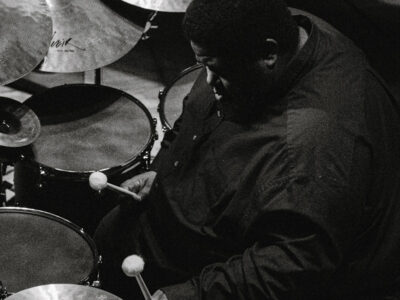
How John Lapinski and a squad of Penn faculty and students backing him up on the NBC News Decision Desk navigated an election season that was unprecedented—and could set a pattern for the future.
By Alyson Krueger | Illustration by Lincoln Agnew

“I just needed to hear John’s voice in my ear,” recalls Rashida Jones, the NBC News senior vice president in charge of election coverage.
It was Saturday morning, November 7, 2020—four days after the polls closed—and the winner had yet to be declared in the presidential election between Donald Trump W’68 and Joe Biden Hon’13.
As it had been since November 4, the NBC News Decision Desk team—led by director of elections John Lapinski, the Robert A. Fox Professor of Political Science and director of the Penn Program on Opinion Research and Election Studies (PORES)—was gathered in a makeshift space inside the Comcast Center in Philadelphia, analyzing returns to make projections for the presidential and other still-undecided races to be used by the network’s various broadcast TV, cable, and streaming platforms.
At that point, the 44 members of NBC’s election night operation—20 of whom were Penn professors or students—had been up nearly 24 hours a day for four days straight. Besides calling races, throughout the process decision desk staff also use exit polls and other data to generate graphs, charts, and blog posts to explain what is happening in various contests, such as how votes broke down by gender or race.
Based on the states that had already been called, NBC’s electoral college count stood at 253–214 in Biden’s favor, with Alaska, Arizona, Georgia, North Carolina, and Pennsylvania still undeclared.
While the goal is to project a winner sooner rather than later, based on analysis of votes collected from key counties across the country, the threshold for making a call is always high—and never more so than in the polarized, pandemic-scrambled election of 2020. “We have to be 99.5 percent confident to project,” says Lapinski.
Voting patterns from past elections were of limited help this time around, since changes sparked by the pandemic—in particular, growth in the use of mail-in ballots—combined with President Trump’s attempts to cast doubt on those ballots and undermine faith in the election, caused voters to behave differently. The political and data scientists had to ask themselves endless variations of questions like, “If Democrats in Arizona’s Maricopa County are mostly voting by mail rather in person, what types of votes are still outstanding?”
On that Saturday morning, Jones, who has since been promoted to president of MSNBC, had an idea that a vote dump was coming in from Pennsylvania that might put the call for that state’s 20 electoral college votes over the edge, pushing Biden past the 270 threshold to win. But she needed to hear Lapinski’s voice to make sure. “He gave us his marching orders,” she says. NBC then publicly declared the win for Biden (seconds after CNN at 11:24 a.m.), and by 11:40 a.m. the Associated Press and other networks had followed suit.
As images of celebrating Biden supporters and protesting Trump followers filled the airwaves, Lapinski and his soldiers resumed counting. “We still had a bunch of other races like Nevada to call,” he says. (That happened around 2 p.m.) The last calls in the presidential race didn’t come until November 13—North Carolina for Trump, Georgia for Biden—to bring the final electoral vote tally to 306–232.
There was other news out of Georgia, too, of course, where both of the state’s Senate elections were headed for runoffs, after incumbent Republican Senator David Perdue fell short of 50 percent of the vote versus Democrat Jon Ossoff while Democrat Raphael Warnock and Kelly Loeffler, a Republican appointed to the seat in 2019, were the top two vote-getters in a multi-candidate field. Both runoffs promised to determine the nation’s trajectory for the next four years, with control of the US Senate hanging in the balance.
One of the more idiosyncratic aspects of the US presidential electoral system is that there is no centralized, governmental body that determines every county and state’s votes on election night. Each state certifies its election results on a different timeline and their votes are formally cast when the electoral college convenes a month or so after the election. The results are then sent to Washington and tallied in a January 6 joint session of Congress (which we learned this year, all too clearly, isn’t always a mere formality.)
That leaves a big gap that the media long ago stepped in to fill.
“In the ’50s and ’60s people used to flock to their local newspapers to find out who won on election night,” says Michael Conway, a television news historian and associate professor of journalism at Indiana University. “They were the ones who got those numbers and counted them first.” (Political parties and candidates also do their own counting, but they can be biased.) While wire services like the Associated Press—which has been calling elections since 1848—and major newspapers remain sources, eventually the action moved mostly to TV, first with the broadcast networks’ election night coverage, then the addition of news-focused cable channels, and more recently the plethora of digital properties offering political coverage on the internet.
This year the media’s role became even more important, because another political tradition was breached. “There used to be this idea that the way we could also know who won the presidency is when the other person conceded,” says Conway, which Trump refused to do.
That put additional pressure on election arbiters like Lapinski and his team. “I don’t want to be melodramatic, but if we screw this up it can be very damaging for our democracy,” he says. “No one wants to get into a Constitutional crisis.”
And not screwing up is getting harder.
In order to make a projection the decision desk must collect voting results from county officials and precincts across the country. But many of those places have proven unwilling or unable to count their votes, especially absentee ballots, as early as possible, leading to longer days or weeks for those calling the races.
“The reason the election wasn’t called on election night 2020 is because the COVID-19 pandemic meant so many ballots were mailed in or dropped off, and many state legislatures’ laws prohibited counting those ballots until polls had closed. There was a huge backlog that took time to get through,” says Emily VanDerWerff, a television critic for Vox who wrote a column that advocated getting rid of election night programming because of this reality.
Even without deliberate delays, local election officials focused on counting the vote don’t always provide the most transparent or thorough information to journalists, leaving decision desks unclear about which votes are left to count and what kind of votes they are. MSNBC analyst “Steve Kornacki was calling Fulton County himself this year while he was on air” trying to get some answers, says Stephanie Perry, manager of polling for NBC News and a member of the decision desk. “We need to reimagine the way we get the most up-to-date information.”
“This year really did feel super, super crazy,” says Lapinski. “On the fly we had to come up with different types of models, different analysis tools, to build as we went along” to deal with the fragmentation of the electorate—into in-person Election Day voters; early mail-in voters; and same-day mail-in voters or people who dropped off their absentee ballot at polling sites (a category that didn’t really exist before 2020)—and create responsive forecasting models. “The good news is we had such an experienced, talented team that we knew how to do that. We were rock solid in this.”
Going forward, Lapinski would like to have better ways to track exactly what type of vote is coming in and how much is outstanding, especially in swing states. “You have to put a lot of resources into being able to do that because it’s a job that takes people power,” he said. “But NBC has already told me they are investing their resources in this. They want to get it right.”
While he was growing up in Seattle, Lapinski’s grandmother inspired his love of the news. “I would watch television with my grandma,” he says. “That was the Tom Brokaw, Dan Rather days. They were big deals.”
He was the first in his family to go to college, completing his undergraduate degree at the University of Washington, where he studied political science. He followed that up with a master’s degree in public policy at the University of Chicago, with the help of a full scholarship. “That’s when I realized I had abilities with numbers and when I started getting a lot of statistics training,” he says.
He received his PhD in 2000 from Columbia University and taught at Yale before coming to Penn in 2006.
Lapinski teaches political science classes, especially those within the department’s data science minor, and is also the faculty director of the Fox Leadership Program and of the Executive Masters of Public Administration program at the Fels Institute of Government. That’s in addition to heading up PORES. The program’s mission is simple, he says: “We train students how to analyze and think about problems using numbers.”
When he’s not pulling all-nighters at the decision desk, Lapinski’s scholarship focuses on using data analysis to understand national elections and Congressional lawmaking. He is the author of The Substance of Representation: Congress, American Political Development, and Lawmaking (Princeton University Press, 2013) and a coauthor of Southern Nation: Congress and White Supremacy After Reconstruction (also from Princeton, 2018).
Currently, Lapinski is working on a report for the American Association for Public Opinion Research, scheduled for release this spring in time for the group’s annual conference, about how to improve polls. “We need to rethink how it is done, how to do it better, but also how the media should be using it,” he says. “People are so obsessed with the numbers, who is going to win, but the media can be doing a better job about how we report out poll numbers.”
Among the biggest flaws he identifies is lack of participation among certain populations, which skews the results. For example, far-right voters, who distrust mainstream media and political organizations, won’t usually answer the phone for pollsters. “There are two ways to think about this,” says Lapinski. “We can figure out how to get more people in the polls. Or we can make some improvements in how we statistically weigh the data, but we have to understand these people better and how they behave before we do that.”
Another issue is predicting the composition of the electorate—how many Democrats and Republicans will vote? This has been a problem for pollsters in both 2016 and 2020, with Trump on the ballot, but may well also continue in the future. “Probably what we will end up doing is to move away from having one hard number to having multiple numbers,” says Lapinski. “We will say if the electorate looks like this, this is what will happen. If it looks like B, this will happen.”
“I got to NBC News by accident,” says Lapinski. Just as he was finishing up his PhD at Columbia and starting at Yale, he aimed to do a big survey studying people’s attitudes about politics. He wanted to conduct the poll on MSNBC.com and was put in touch with the director of elections at NBC. “He told me my project was crap, but he grilled me for a long time,” Lapinski says. “Two weeks later he called me and asked me to be an analyst on the decision desk.”
His first election was the Bush–Gore race that ended up in the Supreme Court. “They sent me home early,” Lapinski remembers. “Only when I woke up the next day did I realize all the crazy stuff that went on.”
NBC, along with other networks, faced backlash from that election after calling Florida for Gore early in the night, retracting the projection, calling the state for Bush, and taking that back in the predawn hours when it became clear there would be a recount.
“The 2000 election led to new innovations and new approaches in thinking about data,” says Lapinski. “When you make a mistake that big, you get a little more cautious.”
Decision desks run simultaneous models to see what outcome they predict. In 2000, they only ran a few of these. Now, they use at least 20, “and we run them millions and millions of times a night,” says Lapinski. “We now run a lot of different types of models to see if they produce the same result. If there is one that doesn’t, we don’t call the race. Instead of assuming that model is the outlier like they might have in the past, we say it might be the right one.”
Another big change at decision desks is how much data with which they have to work. “There have been leaps and bounds in data science from what we had in 2000 to now,” says Lapinski. “It’s light years. We have so much data, that we have to make sure not to get saturated and inundated in it.” For example, decision desks used to only get data at the county level. Now it is broken down into precincts, which means it is much more granular, and the forecasting can be more precise.
By 2013 Lapinski was leading the decision desk, a position that allowed him to staff the team with his people. He turned to Penn. For the 2020 general election, there were nine Penn faculty or staff members working the decision desk.
Every election year Lapinski also brings in undergraduate interns—in 2020 there were 11—who work on inputting exit poll data, building graphs for use on air, fact-checking numbers, and getting vote counts from county and state websites.
College junior Leonard Chen, who is a philosophy, politics, and economics (PPE) major, “was pretty shocked” when he was asked to join the team, he says.
Election night was a whirlwind. “You know that feeling in your chest when you are on a roller coaster?” says Chen. “That’s what it felt like.” He was assigned the task of making graphics and then checking them on air. “There is a lot of scrambling, a lot of yelling, but you get used to it.”
Besides the adrenaline rush, riding the roller coaster could also lead to a job in the future. NBC hires many of the interns that come through the program, Jones says. “You can teach data analysis in the classroom, but it’s another thing to have these students have the live experience of knowing how television works.”
According to Tom Jones, a senior writer for the Poynter Institute for Media Studies, decision desks are more important than ever. “They need to stick to the same mission of calling the results and making the projections when they are ready to be called,” he says. “That’s never been more important than now, when so many Americans, because of the lies they’ve been told that our elections could be rigged, don’t have 100 percent confidence in election results.”
The problem is that forecasting requires an understanding of how the electorate behaves, how certain people in a certain place at a certain time will vote. And a lot of that has changed. “If 2020 is any indication, elections have entered a new phase,” says MSNBC’s Jones.
Perry agrees: “These races are now going to be a lot harder to call.”
Election analysts need a way to identify what kind of votes are coming in at any given time and account for those differences. “It’s not just that mail-in ballots are different from in-person ballots,” Lapinski says. “Different types of mail-in ballots were different. The ones that were dropped off on Election Day looked so different from the ones that came in two days earlier.”
“We have to design and develop tools to help us understand what we are looking at, and what we have and don’t have in the moment,” says Perry. “And these tools need to help us make it reportable to the American public.”
Exit polls have also gotten more complicated to analyze. In 2020, “there were a lot of issues with how people responded to polls,” Lapinski says. For example, it’s no longer helpful to just poll voters who show up on Election Day, because they act very differently than people who vote early by mail (who act differently than people who vote early in person). “Now you have three electorates,” he says.
One thing the 2020 election made clear is that the audience of politics-consuming Americans has a healthy—or maybe not healthy, but voracious—appetite for watching geeky broadcasters operate digital displays and talk numbers for days on end. “I was with other professors who study the media, and they were yelling at the television screen: ‘Where are the numbers? Why aren’t there more numbers?’” says Indiana University TV historian and journalism professor Conway.
Witness the reports that The Gap sold out of khaki pants—signature attire of MSNBC’s boyish on-air data analyst Steve Kornacki, who was also named one of the sexiest men alive by People magazine. (“There is now hope for all of us,” jokes Lapinski.)
More seriously, he has some ideas about how networks should make use of that attention, beyond treating the ups and downs of election night (or week) number-crunching as if it was a football game. “We have to come to a place where people’s faith in the system is restored and people start trusting it,” he says. “I think there is still a lot to learn, and I am not sure it’s fully fixable. But we are at the beginning stages of at least trying.”
More basically, people’s idea of “election night” may have to change. “If every contest takes three or four days, we all can’t physically stay up for that long to cover those,” he said. “We are going to have to teach people to be more patient and know that elections will be called over the span of multiple nights.”
On January 6, Lapinski was back at the Comcast Center collecting votes from county precincts in Georgia, where results of the previous day’s runoff elections were continuing to be tallied. The Warnock–Loeffler race had already been called in Warnock’s favor in the wee hours, but the contest between Perdue and Ossoff was still officially in doubt.
The night before, it seemed the entire country had been glued to their various screens waiting for a winner. But when night turned into day, a fresh news story took center stage: Trump supporters had violently stormed the Capitol as Congress was in the process of certifying the election.
The majority of NBC’s team turned its attention to that shocking development. But as the leader of the decision desk, Lapinski’s job was to keep counting.
“It was kind of surreal,” he says. “As I’m looking at votes, out of the corner of my eye I see police pulling guns at protesters who have breached the Capitol.”
“We called the race at 4:06 p.m.,” says Perry, “but it didn’t even matter—it mattered ultimately, but not on the day we called it.” At the time, the projection wasn’t even announced on live television, only online through social and digital channels.
But once the Capitol was secure and Congress resumed its electoral vote count, the results were waiting that the two Democrats had won their Georgia elections, creating a Democratic majority in the Senate with Vice President Kamala Harris as the tiebreaking vote.
And viewers could rest assured the announcement was accurate. “I wouldn’t say that we waited much longer than being 99.5 percent sure Ossoff would win, but we pushed it a little beyond that,” says Lapinski. “This call, there was no way we could get that wrong.”Calling ItAnd viewers could rest assured the announcement was accurate. “I wouldn’t say that we waited much longer than being 99.5 percent sure Ossoff would win, but we pushed it a little beyond that,” says Lapinski. “This call, there was no way we could get that wrong.”
Alyson Krueger C’07 writes frequently for the Gazette.




